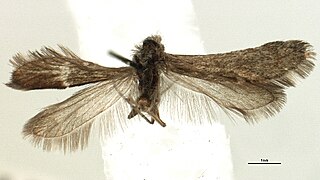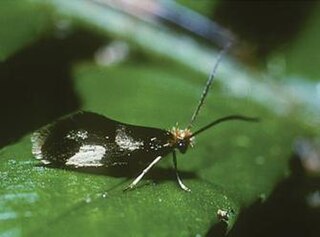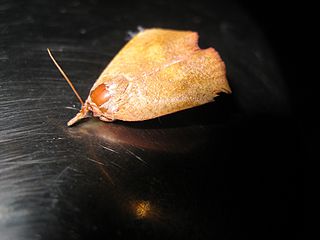
Heterobathmia is a genus of Lepidoptera. It is the only genus in the suborder Heterobathmiina, as well as in the superfamily Heterobathmioidea and in the family Heterobathmiidae. Primitive, day-flying, metallic moths confined to southern South America, the adults eat the pollen of Nothofagus or southern beech and the larvae mine the leaves. Most known species are undescribed.

Lophocoronoidea is a superfamily of insects in the order Lepidoptera. There is a single extant genus, Lophocorona, in the family Lophocoronidae. These are small, primitive nocturnal moths restricted to Australia whose biology is largely unknown.

Sematurinae is a subfamily of moths in the family Sematuridae represented by at least 29 species in the Neotropics.

Ptyoptila is a monotypic moth genus of the family Oecophoridae described by Alfred Jefferis Turner in 1946. Its only species, Ptyoptila matutinella, was described by Francis Walker in 1864. It is found in Australia, where it has been recorded from Queensland, New South Wales, the Australian Capital Territory and Victoria.
Decticogaster is a genus of moths of the family Crambidae. It contains only one species, Decticogaster zonulalis, which is found on Sulawesi.
Amphitrogia is a monotypic moth genus of the family Noctuidae erected by George Hampson in 1926. Its only species, Amphitrogia amphidecta, was first described by Arthur Gardiner Butler in 1879. The species is found in Japan.

Abraxaphantes is a monotypic moth genus in the family Geometridae described by Warren in 1890. Its only species, Abraxaphantes perampla, was first described by Charles Swinhoe in 1890.(Swinhoe, 1890) It is found in Myanmar. & Thailand.
Ithysia is a monotypic moth genus in the family Geometridae. Its only species is Ithysia pravata. The genus was erected by Jacob Hübner in 1825, but the species had been first described by Hübner in 1813.
Lachnocephala is a monotypic moth genus in the family Geometridae described by David Stephen Fletcher in 1953. Its only species, Lachnocephala vellosata, known from Chile, was described by the same author in the same year.

Agrotis amphora is a species of moth of the family Noctuidae. It is found in Kashmir.
Agathiphaga queenslandensis is a moth of the family Agathiphagidae. It is found along the north-eastern coast of Queensland, Australia.
Agathiphaga vitiensis, or the Fiji kauri moth, is a moth of the family Agathiphagidae. It is found from Fiji to Vanuatu and Solomon Islands.
Micropterix purpureopennella is a species of moth belonging to the family Micropterigidae. It was described by Heath in 1986. It is known from Algeria.
Micropterix rablensis is a species of moth belonging to the family Micropterigidae, which was described by Philipp Christoph Zeller in 1868. It is probably restricted to Carinthia in Austria and to the adjacent areas of Styria in Austria and Italy and potentially of Slovenia. Its Croatian, Romanian and French existence is doubtful.

Epimartyria pardella is a species of moth belonging to the Micropterigidae family. It was described by Walsingham, Lord Thomas de Grey, in 1880. Its wingspan is 10–11 mm with a metallic brown forewing featuring three distinctive gold spots. Adults are on wing from early May to mid July and are day active. The larvae feed on liverworts, including Conocephalum conicum and Pellia species and take about two years to fully develop.
Neomicropteryx nipponensis is a species of moth belonging to the family Micropterigidae. It was described by Syuti Issiki in 1931. It is known from Japan.

Hyblaea ibidias is a moth in the family Hyblaeidae. It is found in New South Wales, Australia.
Homoeosoma ephestidiella is a species of snout moth in the genus Homoeosoma. It was described by George Hampson in 1896. It is found in India, as well as on the Malay Archipelago, Fiji, the Pacific islands east of Samoa and American Samoa itself.

The genus Mania comprises a group of tropical and semi-tropical New World moths in the family Sematuridae. The genus has historically been referred to as either Nothus or Sematura, but both of these names are invalid.
Hyblaea sanguinea is a moth in the family Hyblaeidae described by Max Gaede in 1917.






